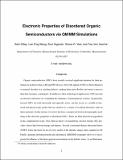| dc.contributor.author | Difley, Seth | |
| dc.contributor.author | Wang, Lee-Ping | |
| dc.contributor.author | Yeganeh, Sina | |
| dc.contributor.author | Yost, Shane Robert | |
| dc.contributor.author | Van Voorhis, Troy | |
| dc.date.accessioned | 2012-03-09T18:58:20Z | |
| dc.date.available | 2012-03-09T18:58:20Z | |
| dc.date.issued | 2010-05 | |
| dc.date.submitted | 2009-10 | |
| dc.identifier.issn | 0001-4842 | |
| dc.identifier.issn | 1520-4898 | |
| dc.identifier.uri | http://hdl.handle.net/1721.1/69632 | |
| dc.description.abstract | Organic semiconductors (OSCs) have recently received significant attention for their potential use in photovoltaic, light emitting diode, and field effect transistor devices. Part of the appeal of OSCs is the disordered, amorphous nature of these materials, which makes them more flexible and easier to process than their inorganic counterparts. In addition to their technological applications, OSCs provide an attractive laboratory for examining the chemistry of heterogeneous systems. Because OSCs are both electrically and optically active, researchers have access to a wealth of electrical and spectroscopic probes that are sensitive to a variety of localized electronic states in these materials.
In this Account, we review the basic concepts in first-principles modeling of the electronic properties of disordered OSCs. There are three theoretical ingredients in the computational recipe. First, Marcus theory of nonadiabatic electron transfer (ET) provides a direct link between energy and kinetics. Second, constrained density functional theory (CDFT) forms the basis for an ab initio model of the diabatic charge states required in ET. Finally, quantum mechanical/molecular mechanical (QM/MM) techniques allow us to incorporate the influence of the heterogeneous environment on the diabatic states.
As an illustration, we apply these ideas to the small molecule OSC tris(8- hydroxyquinolinato)aluminum (Alq3). In films, Alq3 can possess a large degree of short-range order, placing it in the middle of the order−disorder spectrum (in this spectrum, pure crystals represent one extreme and totally amorphous structures the opposite extreme). We show that the QM/MM recipe reproduces the transport gap, charge carrier hopping integrals, optical spectra, and reorganization energies of Alq3 in quantitative agreement with available experiments. However, one cannot specify any of these quantities accurately with a single number. Instead, one must characterize each property by a distribution that reflects the influence of the heterogeneous environment on the electronic states involved. For example, the hopping integral between a given pair of Alq3 molecules can vary by as much as a factor of 5 on the nanosecond timescale, but the integrals for two different pairs can easily differ by a factor of 100. To accurately predict mesoscopic properties such as carrier mobilities based on these calculations, researchers must account for the dynamic range of the microscopic inputs, rather than just their average values.
Thus, we find that many of the computational tools required to characterize these materials are now available. As we continue to improve this computational toolbox, we envision a future scenario in which researchers can use basic information about OSC deposition to simulate device operation on the atomic scale. This type of simulation could allow researchers to obtain data that not only aids in the interpretation of experimental results but also guides the design of more efficient devices. | en_US |
| dc.description.sponsorship | National Science Foundation (U.S.) (CHE-0547877) | en_US |
| dc.description.sponsorship | United States. Dept. of Energy (DE-FG02-07ER46474) | en_US |
| dc.language.iso | en_US | |
| dc.publisher | American Chemical Society | en_US |
| dc.relation.isversionof | http://dx.doi.org/10.1021/ar900246s | en_US |
| dc.rights | Article is made available in accordance with the publisher's policy and may be subject to US copyright law. Please refer to the publisher's site for terms of use. | en_US |
| dc.source | Prof. Van Voorhis via Erja Kajosalo | en_US |
| dc.title | Electronic Properties of Disordered Organic Semiconductors via QM/MM Simulations | en_US |
| dc.type | Article | en_US |
| dc.identifier.citation | Difley, Seth et al. “Electronic Properties of Disordered Organic Semiconductors via QM/MM Simulations.” Accounts of Chemical Research 43.7 (2010): 995-1004. | en_US |
| dc.contributor.department | Massachusetts Institute of Technology. Department of Chemistry | en_US |
| dc.contributor.approver | Van Voorhis, Troy | |
| dc.contributor.mitauthor | Difley, Seth | |
| dc.contributor.mitauthor | Wang, Lee-Ping | |
| dc.contributor.mitauthor | Yeganeh, Sina | |
| dc.contributor.mitauthor | Yost, Shane Robert | |
| dc.contributor.mitauthor | Van Voorhis, Troy | |
| dc.relation.journal | Accounts of Chemical Research | en_US |
| dc.eprint.version | Author's final manuscript | en_US |
| dc.type.uri | http://purl.org/eprint/type/JournalArticle | en_US |
| eprint.status | http://purl.org/eprint/status/PeerReviewed | en_US |
| dspace.orderedauthors | Difley, Seth; Wang, Lee-Ping; Yeganeh, Sina; Yost, Shane R.; Voorhis, Troy Van | en |
| dc.identifier.orcid | https://orcid.org/0000-0001-7111-0176 | |
| mit.license | PUBLISHER_POLICY | en_US |
| mit.metadata.status | Complete | |
